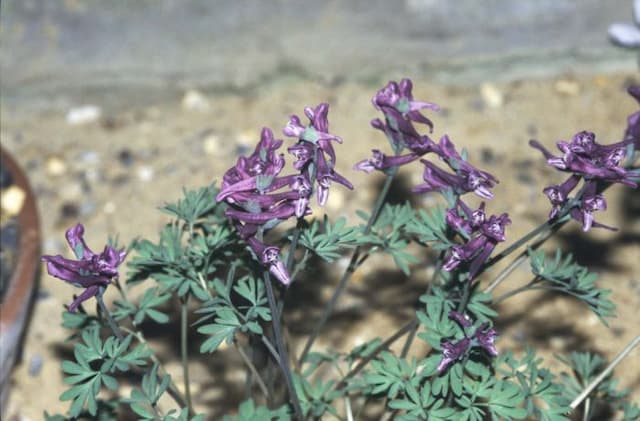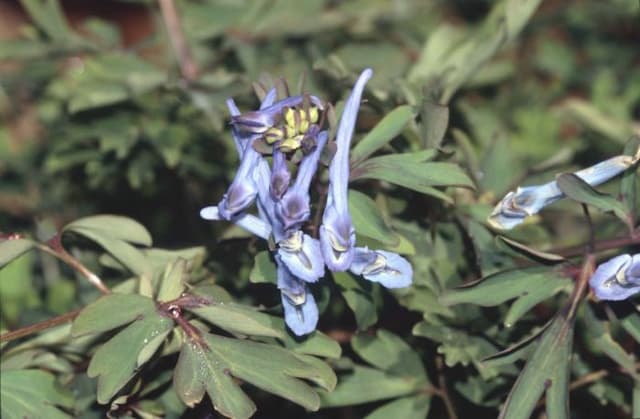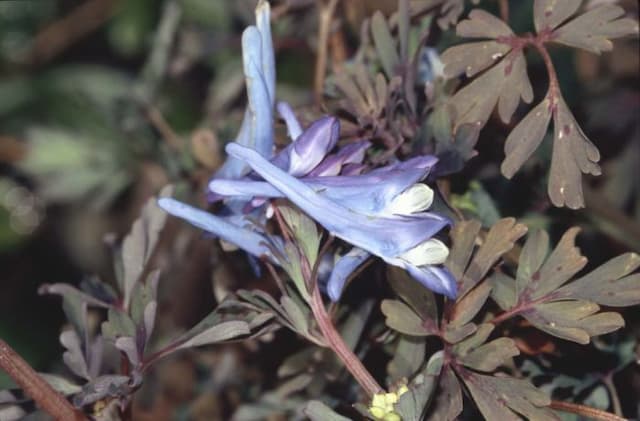Moondance Poppy Papaver 'Moondance'

ABOUT
Papaver 'Moondance' is commonly known as a variety of poppy, specifically bred for its alluring characteristics. This plant produces a stunning display of large, cup-shaped flowers that boast a delicate structure, yet present a dramatic visual impact. The blooms are a captivating creamy-white hue, sometimes with a touch of pale yellow at their base, and their petals exhibit a silky, crinkly texture that is reminiscent of fine tissue paper. At the center of each flower, there is typically a contrasting dark purple or black blotch, along with a generous dusting of black stamens that add to the visual intrigue of the plant. The foliage of Papaver 'Moondance' forms a low clump, with leaves that are deeply lobed and have a hairy, somewhat coarse texture. These leaves are a rich green in color, providing a lush backdrop for the elegant flowers, which stand on solitary, long stems that rise above the foliage in a proud, upright stance. This species of poppy presents its blossoms from late spring to early summer, and the flowers can have a fleeting but breathtaking presence in the garden, often unfurling their petals to reveal their full glory under the warmth of the morning sun. Beyond its blooming period, the plant also produces intriguing seed pods that are often used in dried floral arrangements, which linger on the stalks and add an additional element of interest to the plant's profile after the petals have fallen. The overall impression of Papaver 'Moondance' is one of serene beauty and delicate finesse, making it a cherished addition for gardeners seeking to create a space with a touch of romantic elegance.
About this plant
 Names
NamesFamily
Papaveraceae
Synonyms
Moondance Poppy
Common names
Papaver 'Moondance'.
 Toxicity
ToxicityTo humans
Papaver 'Moondance' is commonly known as poppy. All parts of the poppies can be toxic if ingested in large enough quantities. The poppy plant contains alkaloids such as morphine and codeine which can cause symptoms if ingested. Common symptoms of poppy poisoning include nausea, vomiting, respiratory depression, central nervous system depression, and in severe cases, can lead to coma or death. The extent of the toxicity can vary depending on the amount consumed and the sensitivity of the individual.
To pets
Poppy can be toxic to pets if ingested. The plant contains several alkaloids that may affect the central nervous system. Symptoms of poppy poisoning in pets might include changes in behavior, sedation, uncoordinated movements, constricted or dilated pupils, difficulty breathing, and in severe cases, coma or death. The severity of the symptoms would depend on the size of the pet and the amount of the plant ingested. Pet owners should take care to prevent their animals from consuming poppies.
 Characteristics
CharacteristicsLife cycle
Perennials
Foliage type
Deciduous
Color of leaves
Green
Flower color
White
Height
2-3 feet (60-90 cm)
Spread
1-1.5 feet (30-45 cm)
Plant type
Herb
Hardiness zones
3-9
Native area
Asia
Benefits
 General Benefits
General Benefits- Attractive Blooms: Papaver 'Moondance' produces beautiful white flowers that add elegance to any garden.
- Seasonal Interest: With its flowering season typically in late spring to early summer, it provides visual interest during these months.
- Pollinator Friendly: The plant attracts beneficial insects such as bees, which are essential for pollination.
- Drought Tolerance: Once established, it has good drought tolerance, making it suitable for xeriscaping and low-water gardens.
- Cold Hardy: It is capable of withstanding colder climates, making it a robust addition for many temperate gardens.
- Easy Propagation: Can be easily propagated by seed, allowing gardeners to share and expand their collection without much cost.
- Low Maintenance: Requires minimal care once established, making it a good choice for low-maintenance landscaping.
- Dramatic Seed Pods: After blooming, the plant produces distinctive seed pods that add a different texture and interest in the garden.
- Edible Seeds: Poppy seeds from Papaver 'Moondance' can be used in baking and cooking, offering a culinary use.
- Deer Resistant: Typically not favored by deer, which helps to minimize damage in gardens prone to deer visits.
- Landscape Versatility: Can be used in a variety of garden designs, from cottage gardens to modern landscapes.
- Mounding Habit: Forms neat, mounding clumps that work well at borders or as part of mixed flower beds.
 Medical Properties
Medical Properties- This plant is not used for medical purposes.
 Air-purifying Qualities
Air-purifying QualitiesThis plant is not specifically known for air purifying qualities.
 Other Uses
Other Uses- Papaver 'Moondance', commonly known as poppy, can be used for natural fabric dyeing, providing a range of colors from green to yellow depending on the processing method.
- The petals of the poppy can be pressed and used in crafting, such as for creating bookmarks or decorative items by embedding them within clear resin.
- Poppy seeds from this variety can be incorporated into a homemade exfoliating scrub due to their gentle abrasive texture.
- Dry poppy stems can be included in floral arrangements to add height and an interesting textural contrast.
- Poppies can serve as an educational tool in botany or horticulture classes for studying plant lifecycles and pollination mechanisms.
- The striking appearance of the poppy makes it a popular subject for botanical illustration practice and nature photography.
- The seed pods of poppy can be used for crafting purposes, such as creating unique poppy pod rattles or other decorative art pieces.
- Poppies can be used as part of natural pest control strategies in gardens since they attract beneficial insects like bees and hoverflies.
- Dried poppy plants can be used to make eco-friendly packing material as an alternative to synthetic stuffing or plastic peanuts.
- The poppy's silhouette can inspire textile patterns, wallpaper designs, or other artistic motifs due to its distinctive and elegant shape.
Interesting Facts
 Feng Shui
Feng ShuiThe Poppy is not used in Feng Shui practice.
 Zodiac Sign Compitability
Zodiac Sign CompitabilityThe Poppy is not used in astrology practice.
 Plant Symbolism
Plant Symbolism- Rest - The 'Moondance' poppy, like other poppies, symbolizes rest due to its sedative properties which have historically been used to treat insomnia and promote relaxation and sleep.
- Peace - Poppies are often used as a symbol of peace; after World War I, they became associated with remembrance of soldiers who died in conflict, thus representing a wish for an end to war.
- Remembrance - Poppies, particularly red ones, have been adopted as a symbol to remember fallen soldiers, especially after becoming a poignant emblem following the poem "In Flanders Fields."
- Resilience - Despite their delicate appearance, poppies can thrive in difficult conditions, symbolizing the human ability to endure hardships.
- Beauty and Success - With its captivating blooms, the 'Moondance' poppy represents the pursuit of beauty and success, and the joy of achieving it.
 Water
WaterMoonflower poppies need consistent moisture, especially during the growing season. These poppies should be watered deeply once a week, providing at least one inch of water each time to encourage deep root growth. During periods of drought or extreme heat, water the plants twice a week. Avoid overhead watering to reduce the risk of fungal diseases. Always check the top inch of soil before watering; if it's dry, it's time to water. Reduce watering frequency as the plant goes dormant after blooming.
 Light
LightMoonflower poppies thrive in full sun where they receive at least six to eight hours of direct sunlight daily. Plant them in a location that is exposed to ample sunlight throughout the day to ensure vigorous growth and abundant flowering. Avoid heavily shaded spots, as too little light can lead to weak growth and fewer blooms.
 Temperature
TemperatureMoonflower poppies prefer temperate climates and are hardy to USDA zones 2-8. They can withstand minimum temperatures down to -40 degrees Fahrenheit and maximum temperatures up to 100 degrees Fahrenheit. However, the ideal temperature range for these poppies is between 60 and 70 degrees Fahrenheit to promote the best growth and flower production.
 Pruning
PruningPruning moonflower poppies is not typically necessary. However, deadheading spent flowers can encourage a second bloom and prevent excessive self-seeding. Prune any dead or damaged foliage to keep the plant healthy and tidy. The best time for pruning is immediately after the first flowering has finished.
 Cleaning
CleaningAs needed
 Soil
SoilThe best soil mix for poppies like Papaver 'Moondance' is well-draining with a slightly acidic to neutral pH of 6.0 to 7.0. Incorporate sand or grit to improve drainage and a bit of compost for nutrients.
 Repotting
RepottingPoppies such as Papaver 'Moondance' seldom need repotting, as they are annuals or short-lived perennials. It is best to sow seeds or plant them where they are to grow in the garden.
 Humidity & Misting
Humidity & MistingPoppies like Papaver 'Moondance' prefer average to low humidity levels, as too much humidity can encourage fungal diseases.
 Suitable locations
Suitable locationsIndoor
Grow in bright light, well-drained soil, and cool temperatures.
Outdoor
Full sun, well-drained soil, and protect from strong winds.
Hardiness zone
3-9 USDA
 Life cycle
Life cyclePapaver 'Moondance', commonly known as Moondance Poppy, begins its life cycle with the germination of seeds in late winter to early spring, requiring well-drained soil and some exposure to cold to break dormancy. Seedlings emerge and grow into a rosette of leaves at ground level, where the plant develops a deep taproot crucial for nutrient uptake and drought resistance. As temperatures rise in spring, the rosette of leaves gives rise to a flowering stem growing up to 24 inches tall, bearing large, white flowers with a dark center typical of the Moondance variety. After pollination, typically by insects, the flowers produce ornamental seed pods which, when mature, release seeds for the next generation. The plant is an annual, thus it completes its life cycle within one growing season—after seed dispersal, the parent plant dies. In mild climates or under favorable conditions, some plants may self-sow, thus completing the life cycle through new seedlings the following year.
 Propogation
PropogationPropogation time
Spring-Early Summer
The Papaver 'Moondance', commonly known as the 'Moondance' Poppy, is typically propagated by seed. The seeds can be sown directly into the garden after the danger of frost has passed, usually in late spring or early summer depending on the climate. For best results, the small seeds should be scattered over prepared soil and lightly covered with about 1/16 inch (about 1.6 millimeters) of soil. The area should be kept moist until germination, which usually occurs within two weeks. This method is favored for its simplicity and effectiveness, but it is important to note that 'Moondance' Poppies will not always come true to type from seed if there are other poppies in the vicinity, as cross-pollination can occur.









